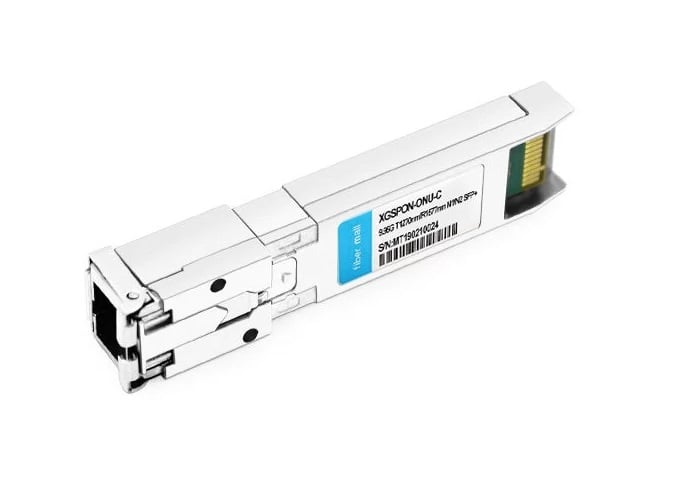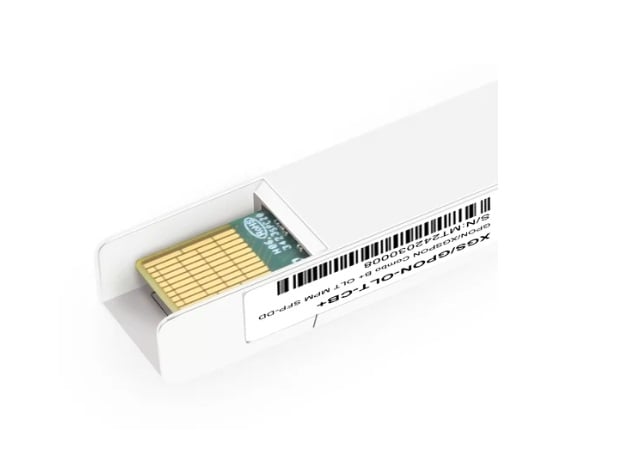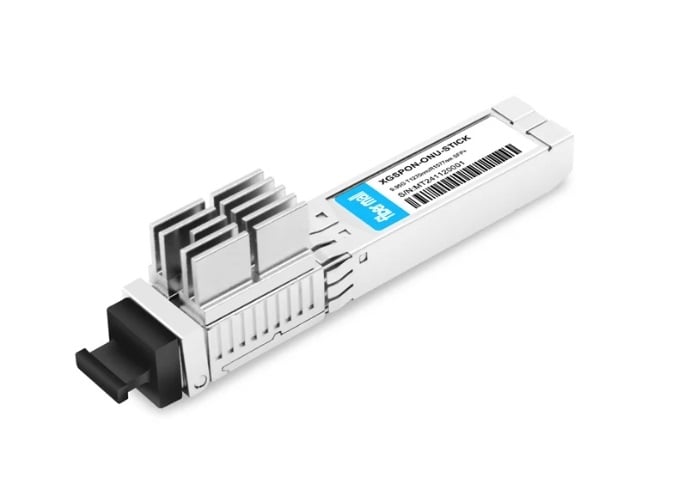In the sphere of fast-changing optical communication, such things as XGS-PON (10-Gigabit-Capable Symmetric Passive Optical Network) are becoming progressively vital as technology advances. This piece seeks to give a detailed account of XGS-PON by looking at its basics and relevance in today’s transceiver technology based on optics. The technological framework, merit, and usage of XGS-PON will be expounded to enable readers to have a well-informed talk on high-speed data transfer implications brought about by this invention alongside predictions for its future in high-speed data transmission.
What is xgspon and How Does it Work?

Defining xgspon: The Evolution of PON Technology
A 10-gigabit-capable Symmetric Passive Optical Network (XGS-PON) is a next-generation passive optical network (PON) technology that offers much higher bandwidth than older systems. These earlier systems include GPON (Gigabit Passive Optical Network), which can reach transmission speeds of 2.5 Gbps. In contrast, XGS-PON provides symmetrical speeds up to 10 Gbps in both downstream and upstream directions. This improvement comes from advancements made in optical transceiver technology and more efficient use of the spectrum available. With wavelength division multiplexing (WDM), XGS-PON can work together with GPON on the same fiber infrastructure for smooth upgrades and backward compatibility. This development addresses the need for faster internet connections while supporting modern applications like cloud computing or streaming 4K videos, which are part of smart home technologies, among others, hence becoming an indispensable component for current and future network architectures.
Working Principles of xgs-pon in Optical Networks
XGS-PON is designed around a point-to-multipoint configuration. In this setup, one optical line terminal located at a service provider’s central office connects with many optical network units (ONUs) through a passive optical splitter placed at end-users locations. The technology uses wavelength division multiplexing (WDM) to allow for transmitting many wavelengths over the same fiber, which makes it possible for XGS-PON and GPON to coexist. The OLT broadcasts downstream data to all ONUs, while each ONU sends upstream data to the OLT. Time division multiple access (TDMA) protocols are employed to prevent collisions among upstream transmissions from different ONUs by assigning specific time slots for each ONU. This guarantees an even flow of information in both directions and supports the higher bandwidth requirements of modern applications.
Comparing xgspon with Traditional GPON
The primary differences between GPON and XGS-PON are their bandwidth capabilities and operational efficiency. In terms of downstream and upstream speeds, GPON offers 2.5 Gbps and 1.25 Gbps, respectively, but XGS-PON achieves a much higher level with symmetrical 10Gbps for both directions. This advance means that XGS-PONS can support ultra-high-definition video streaming (4K) as well as more sophisticated cloud services. Additionally, enhanced wavelength division multiplexing (WDM) techniques enable the coexistence of these two technologies over one fiber infrastructure area or building, etc., which gives a smooth transition from GPON to XGS- PONS, allowing service providers to flexibly scale networks up to meet future needs without necessarily replacing existing infrastructures at large scale.
Key Components of xgspon Systems

Understanding the OLT in xgs-pon
In an XGS-PON system, the Optical Line Terminal (OLT) is the central communication point connecting the service provider’s core network with the end-user’s Optical Network Units (ONUs). Through high-capacity Ethernet connections, this data is translated into an optical signal by OLT, which is then transmitted downstream to multiple ONUs. In the upstream direction, different ONUs’ information is collected and sent back to the core network by OLT. Among other things, advanced OLTs have sophisticated traffic management abilities, quality of service (QoS) prioritization features, and high-level security measures. They can also support both GPON and XGS-PON technologies, thereby enabling a smooth transition/upgrade of network infrastructure. To keep up with this, XGS-PON symmetric high-speed data rates must be maintained; hence, efficient operation of OLTs is necessary for modern bandwidth-hungry applications to work properly.
The Role of ONUs in xgspon Systems
In XGS-PON systems, Optical Network Units (ONUs) are critical. They serve as the last-mile devices that link subscribers to the network of a service provider. ONUs sit at the customer’s premises and receive optical signals from an Optical Line Terminal (OLT), converting them into electrical signals for end-user equipment. In the upstream direction, ONUs collect data from connected devices, convert it back into an optical signal, and send it to the OLT. Some advanced models of ONU can support symmetrical bandwidths of up to 10 Gbps; this means they can efficiently handle high-capacity applications such as ultra-high-definition video streaming (4K), online gaming, or advanced business services. Dynamic Bandwidth Allocation (DBA), Quality of Service (QoS) management, and strong security protocols are among other features that may be found on these types of devices in order to provide a reliable connection for multiple end-users — with each user being able to count on his own secure channel through which he communicates with others over a shared medium.
Importance of Optical Transceivers in xgs-pon
In XGS-PON systems, optical transceivers serve as the optical-electrical converters between the OLT and ONU that make high-speed data transmission possible. These devices belong to SFP+ or QSFP+ modules optimized for XGS-PON’s large capacity, which can reach 10Gbps bidirectionally. They have multiple functions, including low power consumption, extended temperature tolerance, and wavelength stability, so they can work stably under different conditions. One of their advantages is flexibility in network deployment, which enables smooth migration from GPON to XGS-PON, utilizing existing fiber infrastructures. These components must be reliable and efficient because only such connections with high throughput and low latency are suitable for various modern applications, from streaming services to enterprise-level data solutions.
How is Transmission Managed in xgspon?

Optical Signals Transmission and Wavelength Management
For successful data transfer in XGS-PON systems, optical signal transmission and wavelength management are essential. Certain light wavelengths are used to transmit optical signals from the Optical Line Terminal (OLT) to the Optical Network Units (ONUs). Normally about 1577 nm is employed for downstream data while upstream data takes around 1270 nm as its wavelength; this segregates them and helps to reduce interference thereby enabling communication in both directions to be smooth.
In XGS-PON networks, wavelength management involves allocating and tuning these wavebands precisely to optimize the performance of the entire system, besides ensuring that there is no degradation or loss during their travel as optical signals through different components. Advanced transceivers and wavelength division multiplexing (WDM) techniques may be applied to handle more than one signal on a single fiber optic cable, allowing for efficient bandwidth utilization while supporting the high-speed requirements of modern applications. ONT and OLT management systems by network operators dynamically adjust wavelengths and monitor signal integrity, thus ensuring continuity across the whole network.
Upstream and Downstream Transmission in xgspon
In XGS-PON networks, transmission downstream and upstream happens on different wavelength channels to ensure the smooth flow of information while minimizing interference. In most cases, data moves from OLT to ONUs down the line — this is what is referred to as downstream transmission — and it usually takes place at a frequency of 1577 nm. This makes it possible for service providers to distribute high-capacity content such as video streaming and large files.
On the other hand, upstream transmission enables data sent by users’ devices through ONUs back into the network up to OLT; its approximate wavelength is 1270nm. To allow these two-way communications to occur concurrently without any cross-channel interruptions, they are separated using different light frequencies. Time-division multiplexing (TDM) allows more than one ONU to share the same upstream frequency by assigning different time slots for each user’s data stream; this raises the efficiency of systems supporting various present-day applications from home Internet access connections up to enterprise-level services on XGS-PON networks.
Sophisticated management tools monitor such transmissions at all times. They can dynamically reassign wavelengths or timeslots based on current conditions so that performance remains optimal with low latency for reliable service delivery across an extensive area covered by these networks designed for businesses and residential areas.
Challenges in Maintaining Transmission Distance
In XGS-PON networks, there are many technical problems related to maintaining transmission distance. One problem is signal attenuation, which refers to the weakening of an optical signal along the fiber due to its physical characteristics and inherent losses over large distances. Moreover, dispersion can distort signals, especially when they travel for long distances. This results in reduced data integrity with higher error rates.
To address these challenges, network operators can employ different methods such as optical quality components, forward error correction (FEC) techniques, and strategic placement of optical amplifiers within a network, among others. These ensure that the signal travels far enough while still being strong but it is also robust enough. However, balancing between cost and performance is still crucial since some advanced solutions may be costly during implementation and maintenance. Such difficulties can only be solved through good network design accompanied by regular check-ups so that reliable services can be provided over long distances.
Benefits and Applications of xgspon Technology

Symmetric and Asymmetric Bandwidth Capabilities
The XGS-PON technology can provide symmetric and asymmetric bandwidth configurations for different users and applications. In this way, if upload speed matches download speed in a system it is called symmetrical bandwidth allocation which is best suited to applications like video conferencing and cloud-based services that depend on consistent upstream rates as well as downstream rates. Asymmetrical bandwidth differs from the latter because it provides faster downloads than uploads, hence useful for residents who may be mainly streaming videos or browsing websites where much more data needs to be downloaded than uploaded.
Businesses require symmetric bandwidth in their connections so that they can operate at high speeds without any interruptions. Service providers also find this feature important since it allows them to offer fast internet connections that support heavy traffic volumes caused by large data quantities being transferred continuously over the network. On the other hand, asymmetrical systems are advantageous because they enable one to save money while still achieving high-speed broadband coverage, especially among residential areas with limited upstream capacity but high demand for downstream capacity due mainly to streaming services. Such switchable flexibility helps operators fit their networks into different user environments while making efficient use of available resources based on particular needs.
Use of xgs-pon in Broadband and FTTx
Scalable and high-capacity solutions are being provided to broadband and fiber to the x (FTTx) networks by XGS-PON technology. In terms of broadband, XGS-PON allows internet service providers (ISPs) to deliver gigabit-capable broadband services for homes and businesses in order to meet their demand for faster internet and higher bandwidths. This can be seen as a vastly efficient method since it supports very fast downloads while streaming seamlessly and enabling more advanced applications such as augmented reality (AR) and virtual reality (VR).
Long-term scalability benefits are among the many advantages that come with deploying XGS-PON in FTTx networks. The technology works on existing fiber infrastructure, which implies that upgrades can be done step-by-step without necessitating major changes. In this regard, the network is prepared for future data growth rates by ensuring it has enough capacity to handle increased user numbers over time. Additionally, different FTTx architectures like Fiber To The Home (FTTH), Fiber To The Building (FTTB) or Fiber To The Curb (FTTC) are supported by XGS-PON, making it adaptable under various deployment scenarios. Ultimately, the reliability of networks will improve significantly through the deployment of xgs pon into fttx networks; operational costs will decrease considerably while service delivery improves, hence positioning it as a critical enabler for next-generation broadband services within fttx deployments.
Scalability and Flexibility in Optical Networks
The planning and management of contemporary optical networks demand scalability as well as flexibility. It is increasingly necessary for optical networks to support more devices and higher data rates. This means that they should be able to scale in a cost-effective way. Wavelength Division Multiplexing (WDM) is one such technology used by these networks to achieve scalability; it allows for various data signals to be transmitted simultaneously over an individual optical fiber using dissimilar wavelengths that increase network capacity while optimizing the utilization of existing infrastructure.
Flexibility in optical networks can be achieved through reconfigurable optical add-drop multiplexers (ROADMs) in addition to software-defined networking (SDN). ROADMs facilitate real-time dynamic reconfiguration of wavelengths for data routing based on requirements, improving the network’s adaptability. In addition, SDN enhances this flexibility by separating the control plane from the data plane, thereby enabling centralized management and leading to better use of resources. These two technologies enable quick adaptation of optical networks with changing traffic patterns and emerging needs, thus providing a reliable foundation for the delivery of high-bandwidth services and applications.
Integration of xgspon with Existing Networks

Compatibility with GPON and EPON
XGS-PON (10-gigabit Symmetric Passive Optical Network) is designed in such a way that it can work with the current GPON (Gigabit Passive Optical Network) and EPON (Ethernet Passive Optical Network) infrastructures. This backward compatibility guarantees an uninterrupted upgrade from previous PON technologies to XGS-PON, thus preserving sunk costs in existing network equipment. The physical layer of XGS-PON is the same as that of GPON. In other words, network operators are able to use the existing optical distribution network (ODN) for XGS-PON services since they share this common feature. Furthermore, by using wavelength division multiplexing (WDM) techniques, XGS-PON can coexist with EPON which makes it possible for multiple PON systems to operate concurrently over the same fiber infrastructure. Therefore, this intercommunication supports cheaply moving towards higher bandwidth services while still providing service continuity for current GPON and EPON users.
Implementing xgspon in Hybrid Networks
In order to maintain service quality and network efficiency, hybrid networks need to integrate XGS-PON carefully. One way is to use the backward compatibility of XGS-PON with GPON and EPON infrastructure combined with wavelength division multiplexing (WDM). This means that different PON technologies can share the same fiber without significant changes in the optical distribution network (ODN). Moreover, hybrid network architectures may take advantage of XGS-PON scalability, which implies higher bandwidth support and more densely populated users. To ensure successful implementation, operators should consider strategic planning such as phased deployment of XGS-PON equipment as well as stepwise updates on network management systems. Additionally, the adoption of advanced traffic management along with dynamic bandwidth allocation techniques will also improve the performance and reliability of the hybrid network. Operators can effectively integrate XGS-PON into existing infrastructures by following these strategies, thereby resulting in a more resilient and future-proof network that can cater to growing data demands.
Upgrading to xgspon: Considerations and Recommendations
When you move up to XGS-PON, many things should be thought about so as to have a successful result and get the best performance. First and foremost, compatibility with existing infrastructure is critical; this means checking whether the current ODNs can support XGS-PON’s better specs without much modification thus saving time and money too. Secondly, one needs to consider cost-effectiveness, which includes all expenses incurred during the procurement of new equipment, their installation, and training for technical staff if need be. Thirdly, scalability is an added advantage of XGS PON that allows for future expansion without necessarily having to overhaul the whole network in order to meet increasing bandwidth demand.
Moreover, thorough planning ought to be done during the implementation of XGS PON so as not to disrupt service delivery. It would be wise to do it gradually by deploying in phases, starting with areas where high-speed internet is most needed. While doing this, wavelength division multiplexing (WDM) can enable GPON and EPON users to share one fiber, hence ensuring continuity during the transition. Also, dynamic bandwidth allocation (DBA) mechanism adoption could optimize traffic management, thereby improving overall network efficiency plus user experience.
In conclusion, a strategic upgrade approach considering, among others, infrastructural compatibility as well as costs involved in scalability should always be taken into account while upgrading any network system, especially those dealing with higher data volumes like XGSPON.
Future Trends and Innovations in xgspon

Advancements in SFP Modules for xgs-pon
The advancements made in Small Form-factor Pluggable for XGS-PON modules mainly focused on faster data transmission, backward compatibility, and improved energy usage. The current SFP modules can now provide a symmetrical data rate of 10 Gbps which is a big jump from the previous versions. This meets the needs of high-speed internet providers for more bandwidth while keeping latency at bay and allowing higher-throughput.
Another area that has received attention is interoperability with legacy Passive Optical Network (PON) architectures. Engineers have recently been developing new types of SFP transceiver modules so that they work well alongside existing systems. This way, companies can adopt XGS-PON without having to change their infrastructure too much, thus cutting down on deployment costs and complexity. Furthermore, some advanced models incorporate extra diagnostic features which enable administrators to monitor network health in real-time hence detect faults quickly – an important aspect of ensuring quality service delivery.
Significant strides have also been made towards energy efficiency. Power-saving functions are one of the enhancements included in modern small form-factor pluggables (SFPs), as they help lower costs during operations while reducing environmental harm. To achieve this goal globally, overall network power consumption is minimized by employing more efficient transceivers, which take into account the growing necessity for saving energy.
All these developments enhance the robustness, scalability, and future readiness of the XGS-PON networks, thereby enabling service providers to give their customers faster, reliable internet services in different locations around the world.
Predictions for xgspon Technology in Optical Communication
The optical communication industry is on the right track with XGS-PON technology, as it shows some signs of growth. Initially, it can be seen that the need for high-speed internet along with IoT devices will lead to improvements in bandwidth capacity. These future versions are believed to have even faster data rates which could reach 25 Gbps to meet the increasing demand for low-latency services such as VR or online gaming.
Secondly, developments in wavelength division multiplexing (WDM) may also find more extensive application within XGS-PON systems soon enough; this would enable multiple streams of information to travel down one fiber-optic cable at once thereby vastly increasing efficiency and capacity without requiring new fiber placements throughout networks.
Lastly, continuous efforts towards environmentally friendly practices should result in greener XGS-PON solutions being introduced over time. This can involve things like smarter power-saving modes, AI-assisted network management, or using sustainable materials during manufacturing, all of which will contribute towards reducing carbon emissions produced by these networks while still maintaining high levels of performance reliability expected from them worldwide.
These forecasts highlight the potential for XGS-PON technology to revolutionize optical communication and ensure that networks are robust, scalable, and eco-friendly.
Impact of xgspon on Access Network Performance
XGS-PON greatly affects access network performance, as it boosts speed and capacity. According to reports from popular tech sites, XGS-PON offers symmetrical data rates for uploads and downloads at a maximum of 10 Gbps, which is an impressive improvement compared to its forerunners. This widened bandwidth supports high-demand applications like cloud computing, telemedicine, and streaming 4K videos with no noticeable latency.
Furthermore, this technology enhances network reliability and scalability. Service providers can efficiently deal with increasing customer needs because XGS-PON allows more users and devices to be connected without compromising performance. The low latency feature combined with high throughput is especially beneficial in time-sensitive virtual reality or online gaming applications.
Last but not least, XGS-PON brings about cost efficiencies for network operators. By using existing fiber infrastructures together with advanced wavelength-division multiplexing (WDM) technologies, which are included in XGS PON, extensive new deployments will not be necessary, thus saving operators their resources. This approach optimizes resource utilization, leading to reduced operational costs while offering better network performance, hence becoming one of the most attractive solutions for modern optical networks.
Reference sources
Frequently Asked Questions (FAQs)
Q: What is the technology of XGS-PON?
A: XGS-PON or 10G-PON is a more advanced type of passive optical network (PON) that offers symmetrical data transmission speeds up to 10 Gbps for both upstream and downstream traffic. It has been designed to meet the growing need for higher bandwidth in FTTH (Fiber To The Home) networks.
Q: How does an XGS-PON ONU work?
A: An Optical Network Unit (ONU) in XGS-PON, also known as an Optical Modem, is a device that connects end-users to a passive optical network. The device converts optical signals received from the ODN (Optical Distribution Network) back into electrical signals which can be used by subscriber’s devices. The ONU ensures data transmission over long distances, often up to 20km.
Q: What is the function of the splitter in XGS-PON?
A: A splitter in XGS-PON network divides one optical signal from central office into multiple signals so that they can be shared by many users. This passive optic component is cost-effective for distributing internet services among large number of subscribers.
Q: What’s the difference between XG-PON and XGS-PON?
A: While XG-PON supports asymmetric data rates with downstream being upto 10 Gbps and upstream – 2.5 Gbps, XGS-PON allows symmetric data transmission at 10 Gbps both ways i.e., downstream/upstream making it more suitable for applications demanding high bandwidth in both directions.
Q: Can you please elaborate on DDM (Digital Diagnostics Monitoring) in SC UPC optical transceivers?
A: Digital Diagnostics Monitoring or DDM feature in SC UPC optical transceivers provides real-time information about transceiver’s operating conditions like temperature, voltage, power levels etc. This capability is critical for ensuring network reliability and optimal performance especially in high-speed 10G PON deployments.
Q: What are the PON modules and what do they do in XGS-PON networks?
A: The PON modules play a vital role in data processing and protocol management for XGS-PON networks. These modules consist of the OLT optical module that changes electrical signals to light signals when transmitting data through a fiber optic network, or vice versa during reception thus facilitating faster communication across the system.
Q: How does the GPON combo relate to XGS-PON?
A: GPON combo can work together with XGS-PON as one entity which acts as an all-inclusive solution for any kind of network. This means that it is possible for service providers to have different levels of service within their infrastructure i.e., standard Gb/s services along side higher speed Tb/s setup using advanced technologies such as DWDM (Dense Wavelength Division Multiplexing).
Q: What are some advantages of xgspon onu sticks?
A: Compact plugs called ‘sticks’ allow existing PONs offer better speeds without having them replaced altogether; these devices are referred to as xgpon onu sticks. They enable easy upgrade from current passive optical networks (PONS) into 10Gbps per second wavelength division multiplexing (WDM) based systems while still utilizing same cables thus saving time & money spent on rewiring buildings.
Q: What does an OTN function module do in an XGS-PON network?
A: An Optical Transport Network(OTN) function module offers various features, such as multiplexing and error correction coding, among others, which help enhance data security and guarantee reliable long-distance communication over fiber optics used within this type of network.
Q: Why is wireless/5G optical network deployment so important for XGS-PON?
A: Deployments involving both wireless links and 5G radio access technology(RAT) will greatly benefit from integrating them with XGS-PONs since they provide low latency connectivity required by such applications. The integration of these two technologies ensures that there is seamless data access as well as transmission between different parts of a service provider’s network, thus supporting emerging services while enhancing overall performance.
Related Products:
-
 XGSPON-ONU-C XGSPON ONU SFP+ TX-9.95G/RX-9.95G TX-1270nm/RX-1577nm N1/N2 SC DDM 0°C~70°C Optical Transceivers
$75.00
XGSPON-ONU-C XGSPON ONU SFP+ TX-9.95G/RX-9.95G TX-1270nm/RX-1577nm N1/N2 SC DDM 0°C~70°C Optical Transceivers
$75.00
-
 XGSPON ONU Stick Compatible WAS-110 SFP+ TX-9.95G/RX-9.95G TX-1270nm/RX-1577nm SC/APC DDM Optical Transceivers
$160.00
XGSPON ONU Stick Compatible WAS-110 SFP+ TX-9.95G/RX-9.95G TX-1270nm/RX-1577nm SC/APC DDM Optical Transceivers
$160.00
-
 FiberMall XGS/GPON-OLT-CB+ XGSPON GPON Combo B+ OLT MPM SFP-DD TX-9.95G/RX 9.953G, 2.488 Gbps Tx-1577nm/Rx-1270nm SC UPC DDM Optical Transceivers
$300.00
FiberMall XGS/GPON-OLT-CB+ XGSPON GPON Combo B+ OLT MPM SFP-DD TX-9.95G/RX 9.953G, 2.488 Gbps Tx-1577nm/Rx-1270nm SC UPC DDM Optical Transceivers
$300.00
-
 FiberMall XGSPON-OLT-SN1 XGSPON OLT SFP+ TX-9.95G/RX-9.95G, 2.488G Tx-1577nm/Rx-1270nm SN1 SC UPC DDM Optical Transceivers
$300.00
FiberMall XGSPON-OLT-SN1 XGSPON OLT SFP+ TX-9.95G/RX-9.95G, 2.488G Tx-1577nm/Rx-1270nm SN1 SC UPC DDM Optical Transceivers
$300.00
-
 FiberMall XGS/GPON-OLT-CC+ XGSPON GPON Combo C+ OLT MPM SFP+ TX-9.95G/RX 9.953G, 2.488 Gbps Tx-1577nm/Rx-1270nm SC UPC DDM Optical Transceivers
$315.00
FiberMall XGS/GPON-OLT-CC+ XGSPON GPON Combo C+ OLT MPM SFP+ TX-9.95G/RX 9.953G, 2.488 Gbps Tx-1577nm/Rx-1270nm SC UPC DDM Optical Transceivers
$315.00
-
 FiberMall XGS/GPON-OLT-IB+ XGSPON GPON Combo B+ I-temp OLT MPM SFP-DD TX-9.95G/RX-9.95G Tx-1577nm/Rx-1270nm SC DDM -40°C~85°C Optical Transceivers
$315.00
FiberMall XGS/GPON-OLT-IB+ XGSPON GPON Combo B+ I-temp OLT MPM SFP-DD TX-9.95G/RX-9.95G Tx-1577nm/Rx-1270nm SC DDM -40°C~85°C Optical Transceivers
$315.00
-
 FiberMall XGSPON-OLT-SN2 XGSPON OLT SFP+ TX-9.95G/RX-9.95G, 2.488G Tx-1577nm/Rx-1270nm SN2 SC UPC DDM Optical Transceivers
$315.00
FiberMall XGSPON-OLT-SN2 XGSPON OLT SFP+ TX-9.95G/RX-9.95G, 2.488G Tx-1577nm/Rx-1270nm SN2 SC UPC DDM Optical Transceivers
$315.00
-
 FiberMall XGS/GPON-OLT-SBC XGSPON GPON Combo B+ OLT MPM SFP+ TX-9.95G/RX 9.953G, 2.488 Gbps Tx-1577nm/Rx-1270nm SC UPC DDM Optical Transceivers
$325.00
FiberMall XGS/GPON-OLT-SBC XGSPON GPON Combo B+ OLT MPM SFP+ TX-9.95G/RX 9.953G, 2.488 Gbps Tx-1577nm/Rx-1270nm SC UPC DDM Optical Transceivers
$325.00
-
 FiberMall XGS/GPON-OLT-IC+ XGSPON GPON Combo C+ I-temp OLT MPM SFP-DD TX-9.95G/RX-9.95G Tx-1577nm/Rx-1270nm SC DDM Optical Transceivers
$330.00
FiberMall XGS/GPON-OLT-IC+ XGSPON GPON Combo C+ I-temp OLT MPM SFP-DD TX-9.95G/RX-9.95G Tx-1577nm/Rx-1270nm SC DDM Optical Transceivers
$330.00
-
 FiberMall XGS/GPON-OLT-SCC XGSPON GPON Combo C+ OLT MPM SFP+ TX-9.95G/RX 9.953G, 2.488 Gbps Tx-1577nm/Rx-1270nm SC UPC DDM Optical Transceivers
$345.00
FiberMall XGS/GPON-OLT-SCC XGSPON GPON Combo C+ OLT MPM SFP+ TX-9.95G/RX 9.953G, 2.488 Gbps Tx-1577nm/Rx-1270nm SC UPC DDM Optical Transceivers
$345.00
-
 FiberMall XGS/GPON-OLT-SBI XGSPON GPON Combo B+ I-temp OLT MPM SFP+ TX-9.95G/RX 9.953G, 2.488 Gbps Tx-1577nm/Rx-1270nm SC UPC DDM Optical Transceivers
$345.00
FiberMall XGS/GPON-OLT-SBI XGSPON GPON Combo B+ I-temp OLT MPM SFP+ TX-9.95G/RX 9.953G, 2.488 Gbps Tx-1577nm/Rx-1270nm SC UPC DDM Optical Transceivers
$345.00
-
 FiberMall XGSPON-OLT-SIN1 XGSPON OLT SFP+ TX-9.95G/RX-9.95G, 2.488G Tx-1577nm/Rx-1270nm SN1 SC UPC DDM Industrial Optical Transceivers
$360.00
FiberMall XGSPON-OLT-SIN1 XGSPON OLT SFP+ TX-9.95G/RX-9.95G, 2.488G Tx-1577nm/Rx-1270nm SN1 SC UPC DDM Industrial Optical Transceivers
$360.00
